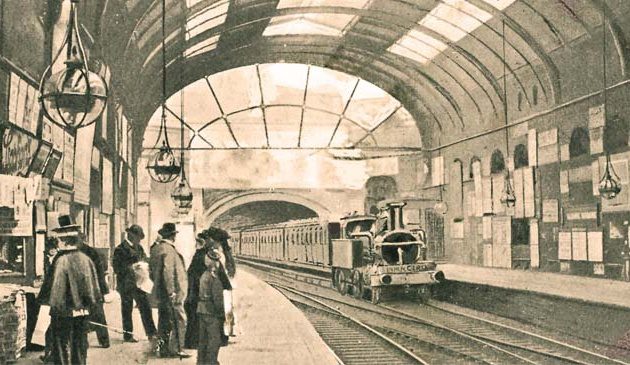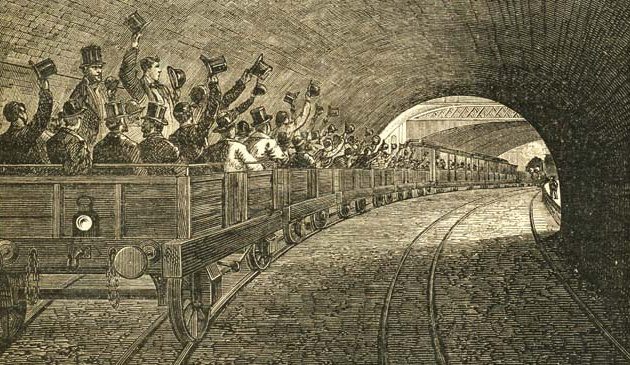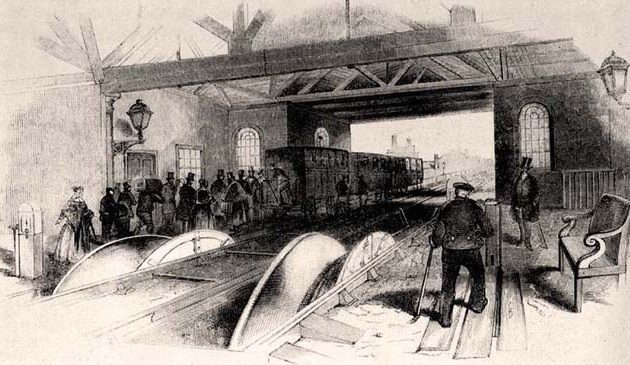London’s horse-drawn trams
Omnibuses became a common sight on London’s streets during the 1830s and allowed workers who could afford the ticket prices to travel from suburbs into their place of work in the City or Westminster. During the 1870s numerous tram lines were created along London’s streets, competing with the many omnibuses on the same routes.

Double-deck horse-drawn tram No. 217 at Clapton Pond in Hackney at the start of its journey to Moorgate in about 1879. Like many others, this tram had ‘knife-board’ seating on which passengers on the top deck sat back-to-back facing outwards.
With the introduction of horse-drawn omnibuses into London from 1829 workers could for the first time travel further than walking distance to their place of work. Yet an omnibus full of people was heavy to pull, which limited their size and the number of passengers that could be accommodated. That made journey prices too high for most manual workers and they were mostly used by the management classes. Trams running on rails, however, had the advantage that two horses could pull a heavier load than an omnibus. They were therefore larger and could carry a greater number of passengers with lower fares, making them more accessible to the lower-paid working classes.
The world’s first tramline was in Swansea, which operated between 1807 and 1827. However, they developed further in the United States where, unlike Europe, city streets were too poorly paved for omnibuses to comfortably travel. Trams were running in Baltimore by 1828 and in New York in 1832.
Trams were first briefly introduced to London by the aptly-named American entrepreneur George Francis Train. As a young man he had managed the Liverpool office of the family shipping company. He then travelled the world, during which time he created a rail line in Melbourne, Australia, as well as making a considerable amount of money there as a merchant. Back in America he helped promote the Atlantic & Great Western Railroad. In Philadelphia he had seen street cars in operation and decided to bring the idea to London, then the largest city in the world. However, he was refused permission in the capital. He then tried in Liverpool, the city he knew well, and where William Curtis had reached agreement with the dock company to run his ‘railway omnibus’ on their track system. However, Train had aggravated the city authorities during his time at the shipping office and they also refused permission. Just across the River Mersey from Liverpool is the town of Birkenhead, on the Wirral peninsula. It was there, with the support of the shipbuilder John Laird, that Train finally gained permission to run a 2½ mile tram line, opening in 1858. Train brought George Starbuck to England from America to help him set up the line.
Train was still determined to establish tram systems in London. Once the Birkenhead line was running he moved to London and began to meet with influential people. He obtained permission from the Commissioners of the Metropolis Roads to lay an experimental line a mile in length along Bayswater Road westwards from Marble Arch. Starbuck served as managing director of the company. Iron tracks were laid on the surface of the road, with the four-wheeled tramcars held in place by the raised outer edge of the track, although they frequently derailed. The single-deck cars were drawn by two horses. They accommodated twenty sitting passengers and a further twelve standing, with the latter holding onto straps hanging from the ceiling. (The straps were later reintroduced onto London’s tube trains). It opened in March 1861, with a celebration turtle lunch held at Marble Arch.
A second line was laid along Victoria Street from Westminster Abbey to Victoria station, opening in April 1861 with a celebration American breakfast. In June Train applied for extensions to the lines but there was opposition to his tram venture. Unlike later tramlines his rails sat above the road surface and were therefore a hazard. He had also run his routes along fashionable streets where influential residents complained of the noise of the tramcars. The roads commissioners gave notice for the tramways to be removed. After just a few months a boy died after being hit by one of the trams. Train was arrested and put in jail but later acquitted.
He had obtained permission from the Lambeth Vestry for a third tramway along Kennington Road and Westminster Bridge Road. The matter went to the Surrey Assizes in October due to the opposition. They determined that his trams had been obstructing the streets and that he had laid the lines without obtaining an Act of Parliament. Train attempted to retrospectively gain parliamentary approval but without success and was forced to give up the venture. He returned to America where he bought up wilderness land along the Union Pacific Railroad, developed it, and then made his fortune when the land was sold. Starbuck remained in England. He set up a tramcar factory in Birkenhead, the first outside the United States, which became the largest manufacturer of tramcars in Britain, supplying towns in Britain and overseas until 1914.
Train was unfortunate in being in the vanguard of tramways. In the decade following his attempts there was a change in public opinion. Parliament passed an Act in 1868 authorizing the laying of a tramway in Liverpool and that finally jolted London into action. Various Acts were passed during 1868-1870 for the Metropolitan Street, North Metropolitan, Pimlico, Peckham & Greenwich, and London Street companies to each lay individual tramways totalling over 82 miles, providing that tracks were recessed into the roadway. The Tramways Act of 1870 made the Board of Trade the authority for giving assent to the laying of lines. Schemes of a further 266 miles of tramway in the metropolis were submitted to the Board during 1870-71. The tram companies were responsible for maintenance of the roads along which their routes passed, relieving rate-payers of the cost. The various companies adopted the same gauge so that networks could link with one another.
The first route to open under parliamentary authority was the Metropolitan Street Tramway Company’s line between Brixton Hill and Kensington church in May 1870. That December it was extended to the south side of Westminster Bridge. The company amalgamated with the Pimlico, Peckham & Greenwich company to form the London Tramways Company and by September 1871 had 14½ miles of tracks across south London.
The North Metropolitan Company was the most important of the tram companies. Their first line of 2½ miles opened between Bow church and Whitechapel church, just seven days after that of the MST Co’s. There was a special fare for workmen of one penny between 5.15am and 7am, after which it rose to two pence. It was extremely popular, carrying over a million passengers in the first six months. The line was extended to four miles, west to Aldgate and east to Stratford, opening in November. In 1873, to prevent the dodging of fares, the company began issuing a voucher upon payment, to be returned when alighting. From 1895 they issued return tickets printed in two halves, the return section usable at any future time. The following year the company introduced a night-service for market porters, leaving Highgate every 30 minutes from 3am and similarly from Finsbury Park at 3.15am. The two routes merged at Holloway Road so that trams were every 15 minutes from there to Aldersgate Street.
The London Street Tramway Company’s routes were initially in the north-western suburbs, such as from the bottom of Highbury Hill, through Kentish Town, to Tottenham Court Road, and Holloway Road, through to Camden Town and King’s Cross. In about 1880 they extended their system from Highbury station, through Canonbury, Essex Road, and along New North Road. There it joined the Green Lanes to Moorgate route.
Tramlines were limited to the suburbs. The vestries of St. George’s Hanover Square and St. Marylebone did not welcome large numbers of vulgar working classes arriving by tram. The North Metropolitan obtained parliamentary sanction for several lines in the City, connecting stations at Moorgate, Aldgate and Aldersgate but subject to approval by the City of London Corporation, which was never given. The LT Co’s lines reached to the southern ends of Westminster and Blackfriars bridges yet they could not obtain agreement from the bridge owners to lay their tracks over them and carry the passengers into the City and Westminster. The bridges that were privately-owned such as Waterloo and Southwark demanded a price that was too high. Similarly, the NM Co.’s routes reached as far as Moorgate, Aldgate and Aldersgate but could not penetrate the City. An LT Co. route began from Victoria station, along Vauxhall Bridge Road to the south of Vauxhall Bridge. From November 1873 they laid on omnibuses to take passengers over the bridge to connect with tram routes on the other side. It was only in the 1890s that the London Country Council successfully promoted parliamentary Bills for lines to cross Vauxhall, Westminster and Blackfriars bridges.
In the summer of 1875 the NM Co. were running 164 trams on 29½ miles of track, with horses supplied under contract from the London & General Omnibus Co. During the first six months of that year they carried nearly 13½ million passengers. The LT Co. ran 139 trams over 20¼ miles, with 1,200 horses, with over 7½ million passengers. The London Street operated just 48 trams on 4½ miles, with 400 horses and over 2½ million passengers. These were quite significant numbers of passengers considering there were numerous omnibuses running on the same routes.
Early tramcars were manufactured in New York but new designs were later produced in England. Cars of each route were painted in a particular colour, enabling travellers to know the destination. Oil lamps illuminated the insides at night, using similar colours to the outside. As they appealed to the more working-class people, trams had on-board accommodation for luggage such as workmen’s tools and market baskets. The normal capacity of horse-drawn trams was forty-six.
The grooves of tramlines had to be cleared of mud during the days of horse-drawn trams. Two men would walk side by side along the tracks, using a special kind of deep shovel on a long handle that collected the mess. Each time the shovel was full the contents were deposited in the gutter on the side of the road.
A limitation of trams was in ascending and descending steep inclines. A ¾ mile-long line was created on the steep road from Archway Tavern up Highgate Hill by Andrew Smith Hallidie, inventor of the San Francisco tramway system, opening in May 1884. The tram was towed by a car attached to a continuously moving cable below the road surface, which was powered by a steam engine. Passengers were happy to pay the fare to ascend the hill but less so for the downhill journey. The line closed after ten years following a serious accident. It reopened again in 1897 under new ownership and reconstruction. London Tramways installed a lengthy cable traction system on Streatham Hill from 1896.
Another method used on steep inclines was to temporarily attach a third horse, known as a ‘cock horse’. During that part of the journey a boy travelled with the driver, jumping off at the top of the incline and riding the horse back to the bottom of the rise to meet the next tram.
In November 1873 experiments began with steam-powered trams. There is no available record of them being used within inner London but they certainly operated on a route from Finsbury Park to Stamford Hill and Edmonton. Experiments took place in March 1897 on the London, Deptford & Greenwich Company’s system along Rotherhithe New Road using an electric tram propelled by battery-storage.
The Tramways Act of 1870 gave local authorities the right to take over tramlines in their area, although not to actually operate the tramcars. In London that power was given to the Metropolitan Board of Works but they never exercised their right. The London County Council was formed in 1889, inheriting from the MBW the power within the area of the newly-formed County of London. Two years later it decided to take up its option regarding tramways, at which time there were fourteen tramway companies in the capital. After some haggling over the price, the LCC purchased 4½ miles of the London Street Tramways lines in 1895. The LST continued to operate the trams on the lines. The following year the same arrangement occurred with the North Metropolitan’s lines.
At the end of the century there were over 115 miles of tramlines in the County of London, with over 340 million journeys taken each year. New forms of transport that were created in the 19th century allowed people to speedily commute longer distances from their home to their place of work. Omnibuses, affordable to the managerial classes, encouraged the growth of new suburbs for the middle classes to the north and west of the capital. The more affordable trams encouraged the growth of suburbs for working people to the south and east.
The London County Council Act of 1896 gave the LCC the power to operate tramcars. It then acquired the London Tramway’s lines in 1899 and at the same time began taking over running of the trams on all lines it had purchased.
The first electric tramline was opened by London United Tramways in 1901 between Shepherds Bush, Chiswick and Kew. Later that year the last tramway to be laid using horse-drawn trams began operating from Hampstead to Camden. In 1903 the LCC began operating electrified trams. The final horse-drawn tram ran in April 1915.
Sources include:
- G. A. Sekon ‘Locomotion in Victorian London’
- Jerry White ‘London in the 19th Century’
- David Voice www.tramwayinfo.com
- John Richardson ‘The Annals of London’.


